You are using an out of date browser. It may not display this or other websites correctly.
You should upgrade or use an alternative browser.
You should upgrade or use an alternative browser.
Battery Ageing Model
- Thread starter JejuSoul
- Start date

Help Support Kia Soul EV Forum:
This site may earn a commission from merchant affiliate
links, including eBay, Amazon, and others.
-
There's a really interesting blog post with a lot of great analysis / data here - What can 6,000 electric vehicles tell us about EV battery health?
They have a fantastic online EV Battery Degradation Comparison Tool
However I am skeptical about their results, particular for the Soul EV.
An image from the Geotab data showing SoulEVs from 2017 and 2018
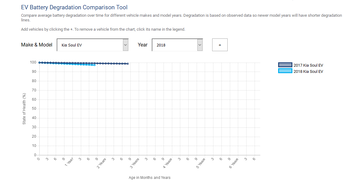
This is interesting. We have no data for degradation from the 2018 Soul EVs at all. Kia removed the Min and Max deterioration counters, so I'm wondering what exactly Geotab is measuring. Also we don't know if they are using SOH of total capacity or usable capacity. There is no mention or vision in their graph of a 10% buffer at the top.
There's a really interesting blog post with a lot of great analysis / data here - What can 6,000 electric vehicles tell us about EV battery health?
They have a fantastic online EV Battery Degradation Comparison Tool
However I am skeptical about their results, particular for the Soul EV.
An image from the Geotab data showing SoulEVs from 2017 and 2018

This is interesting. We have no data for degradation from the 2018 Soul EVs at all. Kia removed the Min and Max deterioration counters, so I'm wondering what exactly Geotab is measuring. Also we don't know if they are using SOH of total capacity or usable capacity. There is no mention or vision in their graph of a 10% buffer at the top.
I did not replace any cell yet, The workshop did not give any guarantee about the improvement I will get after replacing the cells, in addition the cost became around 800$.
While my car SOH dropped to 59.9%, the range is around 100 - 110 Km's in this cold weather.
So I found another car workshop!, This one seems more professional. This shop offers also 40 kWh, and 64 kWh batteries for Kia Soul EV's!. These batteries are Hyundai Kona ones. The smaller one is sold for 5,000 $ while the bigger one for 7,000 $. The 40 kWh battery could get 168 miles after installing it in a Soul EV.
I am thinking to get the 40 kWh battery and keep 2 year more, or to repair mine then get a Kona Electric or a prius prime 10 months later. Still not sure!
Now in the Jordanian market, there are many Souls that have their batteries degraded sharply. I can see that around 2 thirds of the cars offered for sale (around 30 cars usually) actually have degraded batteries.
While my car SOH dropped to 59.9%, the range is around 100 - 110 Km's in this cold weather.
So I found another car workshop!, This one seems more professional. This shop offers also 40 kWh, and 64 kWh batteries for Kia Soul EV's!. These batteries are Hyundai Kona ones. The smaller one is sold for 5,000 $ while the bigger one for 7,000 $. The 40 kWh battery could get 168 miles after installing it in a Soul EV.
I am thinking to get the 40 kWh battery and keep 2 year more, or to repair mine then get a Kona Electric or a prius prime 10 months later. Still not sure!
Now in the Jordanian market, there are many Souls that have their batteries degraded sharply. I can see that around 2 thirds of the cars offered for sale (around 30 cars usually) actually have degraded batteries.
-
I took my white car to the main Kia service center in the city today for a battery replacement.
There were multiple stacks of crates containing new batteries. I counted 36. All for the Soul EV.
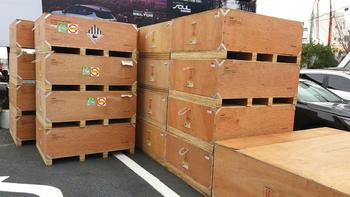
Going there the 50km trip took 50% of the old battery.
Returning the same journey took 22% of the new battery.
I will post more details later.
2016 Soul EV+ Battery Replacement - Remanufactured?
I took my white car to the main Kia service center in the city today for a battery replacement.
There were multiple stacks of crates containing new batteries. I counted 36. All for the Soul EV.

Going there the 50km trip took 50% of the old battery.
Returning the same journey took 22% of the new battery.
I will post more details later.
2016 Soul EV+ Battery Replacement - Remanufactured?
Omar said:Now in the Jordanian market, there are many Souls that have their batteries degraded sharply. I can see that around 2 thirds of the cars offered for sale (around 30 cars usually) actually have degraded batteries.
I'm curious about the prices. Do they advertise cars with degraded batteries?
There are around 15 cars with degraded batteries. Their prices start from 11,000 dollars up to 14,500 dollars. Good cars prices are around 17,000 dollars.
I visited the car shop yesterday and discussed with him how to fix my car.
He agrees with me about the main reason of Kia souls batteries degredation. It is the high regenerative power!. Clearly the soul battery does not like high charging power. If your terrain is is up and down like our city, then you got a serious problem, so almost all soul 2015 cars standing for sale have degraded batteries. The good ones are of newer year model.
About my car, he claims that too many cells are degraded, so his only suggestion is to replace my battery. But I don't trust his judgement, maybe he wants just to get more money! Or maybe he wants the good cells out of my battery so he can do business!
He waa trying to scare me and push me to agree with him. He says if you replace few cells then others will degrade within a month. I am doubtful!
I visited the car shop yesterday and discussed with him how to fix my car.
He agrees with me about the main reason of Kia souls batteries degredation. It is the high regenerative power!. Clearly the soul battery does not like high charging power. If your terrain is is up and down like our city, then you got a serious problem, so almost all soul 2015 cars standing for sale have degraded batteries. The good ones are of newer year model.
About my car, he claims that too many cells are degraded, so his only suggestion is to replace my battery. But I don't trust his judgement, maybe he wants just to get more money! Or maybe he wants the good cells out of my battery so he can do business!
He waa trying to scare me and push me to agree with him. He says if you replace few cells then others will degrade within a month. I am doubtful!

$39.99
Car Floor Mats for 2010-2020 Kia Soul. Rubber Car Floor Liners Set All Weather Protection Heavy Duty Black 3pc Pack
DONA REPLACEMENT PARTS

$85.99
$107.99
Powerbuilt 5-Piece Box End Insulated VDE Wrench Set, Rated for 1000V, Sizes 7mm-14mm, Electric and Hybrid Vehicles, Home Electrical and Car Repair - 642962
Northern Tool + Equipment

$39.99
Car Floor Mats for 2015-2019 Kia Soul EV. Rubber Car Floor Liners Set All Weather Protection Heavy Duty Black 3pc Pack
DONA REPLACEMENT PARTS
Omar said:...Now in the Jordanian market, there are many Souls that have their batteries degraded sharply. I can see that around 2 thirds of the cars offered for sale (around 30 cars usually) actually have degraded batteries.
That sounds possible if most of these cars have been bought over from the US. In 2014 and 2015 most of the Soul EVs in the US were in the warmer states. (California, Georgia, Texas) It is the heat that has caused such rapid degradation. With very high ambient temperatures the battery will degrade fast irrespective of how the car is driven.
Here's a poll from the Kia Soul EV facebook page. A third of the US owners have done or soon expect battery replacement.
The poll will include all the newer 2018 cars that don't have degraded batteries yet.
And all the Soul EVs in the cooler climate of the Pacific North West.
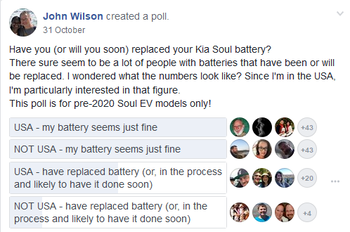
The rest of the world is at about 10% on this poll. I expect this number to increase considerably before warranty expires.
I was told at the Kia service center that many owners here are experiencing sudden deterioration after about 80,000km.
-
If we talk about the price of used 2015 Soul EV's here on Jeju island, It is between 12,000 to 14,000 USD. The state of the battery is irrelevant. What matters is the odometer. My car with a replaced battery will not gain any value at all from the price I bought it for six months ago. This makes sense if you realise that the most important factor is when the warranty expires. I doubt this is the reason for the valuations, but it does make sense.Omar said:...There are around 15 cars with degraded batteries. Their prices start from 11,000 dollars up to 14,500 dollars. Good cars prices are around 17,000 dollars....
-
JejuSoul said:If we talk about the price of used 2015 Soul EV's here on Jeju island, It is between 12,000 to 14,000 USD. The state of the battery is irrelevant. What matters is the odometer. My car with a replaced battery will not gain any value at all from the price I bought it for six months ago. This makes sense if you realise that the most important factor is when the warranty expires. I doubt this is the reason for the valuations, but it does make sense.
Because there, all the cars are under warranty, but in the Jordanian they are imports, so, out of warranty.
I had my Kia Soul EV at the dealership for 120 000 km (75 000 miles) service at the beginning of December. The authorized dealer did a reading at 83 % SOH (I read 82.8 % in the Kia Soul EV Lite app at the same time). Just a few weeks earlier the app was showing 76.1 % and now (6 weeks after service) it is showing 72.3 %. Is it common with this much variation between the readings each time the car calibrates/calculates the SOH? Does anything (eg. temperature, recent consumption details, or other factors) affect the input of the calculation?
Edit (update): And later today it now shows 69.3 %
Edit (update): And later today it now shows 69.3 %
Yes. The values for deterioration fluctuate a lot. (Maybe +/- 5%, maybe related to temperature, charging, driving speed.)Zattaxu said:... Is it common with this much variation between the readings each time the car calibrates/calculates the SOH? Does anything (eg. temperature, recent consumption details, or other factors) affect the input of the calculation?...
Normally I prefer to plot the data and use a trend to find the SOH, because that removes some of the randomness.
The only time it is worthwhile to know the exact value the car is reporting is when you have to get the battery changed.
Kia service will use the value on the day it is checked.
I took my car in to get checked the day it hit 40% Maximum deterioration. That triggered the warranty.
3 months later when I took the car in to get the battery replaced the deterioration had gone down, and was below the warranty line.
They did not check a second time.
Here is a chart showing the MIn and Max deterioration counters on my car.
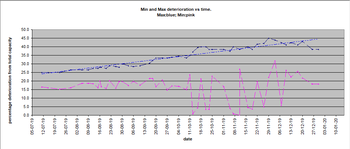
For a good battery I prefer to use an average of the Min and Max to find the SOH. This gives better results when charted.
But as the chart shows, once the battery has gone 'bad' the Min value becomes meaningless.
The SoulEVSpy app always uses the Max value to calculate SOH.
I took the liberty of translating some answers to a facebok post on the Norwegian Kia Soul EV forum. The question was: How many has driven the car more than 100 000 km, what SOH do you have, and what does the GOM say.JejuSoul said:Thanks for posting Zattaxu. This is the first battery replacement story from Norway I have seen.Zattaxu said:...There have been reports of failing battery packs also in Norway. As some owners has had their cars 5 years (first cars were delivered autumn 2014) many owners has reached 100.000 km (appx 60.000 miles) or more. I don't know the percentage which have claimed replacement, (Norw. warranty: 70 % capacity after 150.000 km/7 years), but my impression from Norw. EV forums/Facebook groups is that a lot of owners of the cars which have passed 100.000 km are experiencing degradation problems. Some have had their battery packs replaced after waiting up to 6 months on a new pack...
I have just read your post on elbilforum.no - Mistet kapasitet på fremdriftsbatteri - erfaringer?
I still think that as a percentage the failure rate in Norway will be much lower than elsewhere. At present almost 42% of all Soul EVs ever produced are in Norway. Clearly some of those cars are now failing. But I assume many are not.
I base this assumption on the N issan L eaf, which has a high failure rate in the USA and a low failure rate in Norway.
Am hoping the Soul EV doesn't turn out to be worse than the L eaf.
If it is, then it means we have been looking in the wrong direction 'high temperatures' as the cause of most battery failures. Instead it may be 'battery stress' caused by long and fast journeys that are the primary cause.
I guess that most people are refering to the SOH from what the dealer reported last time they had their service (normally: every 15.000 km in Norway), but 11 people replied (as I mentioned before, others to have reported their batteries degrading more now, than before).
1: Mileage: 115000 km. 84 % SOH, GOM says about 114 km.
2: Mileage: 180000 km. Got new battery at 120000 km.
3: I'm just under 110,000 on my 2016. Can't remember what it said on the battery part, but the SOH was in the 90s somewhere.
4: Milage: 125k. Battery 80%. GOM says 102 km fully charged.
5: Milage: 130k. Battery degrading fast. Should get it checked but think it is approaching 70%. GOM says 70 km on full charge.
6: Milage: 117k measured it at 90k. Was 93% - guess it has dropped 7%. About 100+ km on GOM.
7: Mileage: 105 000km. SOH last reports of 94%, 90%, 100%, 86 % and on last service 92%. Don't trust the SOH dealings from your reader. GOM at about 120km.
8: I got my battery replaced on warranty at 120,000 km. Was then under 70%
9: Mileage: 135k run, 75% SOH, shows about 90 km fully charged.
10: Approximately 120,000 km and 83 % SOH. Gets 90 km fully charged.
11: If this is true I will get a new battery soon. Has driven 116,000 and can run 94 on full tank.
My mileage is 122 000 km (first time registered Nov 2014) and SOH is at 69.3%.
ZuinigeRijder
Well-known member
- Joined
- Dec 31, 2015
- Messages
- 138
ZuinigeRijder said:My Kia Soul EV from September 2014 has now driven 108251km and the SOH is now 93.55%. Note that the previous owner already got a SOH of approx. 102% after the first year.
Seems that it pays off to mainly charge till 80% SOC (yes, my model has still the option to charge till 80%) and try to keep it above 30%. I also do not drive fast, mostly 90 km/h on highway. My average speed is 57 km/h in the board computer. Also try to park/charge in the shadow. My car has now also the possibility to fastcharge to 91% instead of 86%, but I never used it, because fast charging above 80% takes more time (because it will not charge with 50 kW). I do not use fast charging often.
These are the latest readings of TorquePro, after a charge from 13% till 100% with the home charger:
....
Here an update after 127544 km on the ODO meter for my Kia Soul EV from September 2014 . The minimum deterioration is 15.9 and maximum deterioration is 18.3, giving an average of 17.1. The State Of Health (SOH) is according to the Torque calculation 92.9%. The Cumulative Energy Discharged (CED) value is 22306. This means that calculating with 27 kWh battery I have used 826 charge cycles.

Still going strong.
Yes. That is strong.ZuinigeRijder said:...Still going strong...
You will be over the 150,000km warranty limit in less than 12 months time. And very unlikely to get a replacement battery by then.
If degradation continues in a linear fashion your car will not reach 70% degradation until 300,000km.
Other cars have shown the degradation line falling off a cliff. How or why that happens is currently unknown.
That decline has not been seen in any of the cars we have been testing from the start.
My blue car. A 2015 Soul EV has 69,250km and an SOH of about 94%.
It's good but not as strong as yours. I also drive carefully and only charge to 80%. Am guessing it;s because I have much hotter summer weather than you. I still have many years before the warranty runs out, and I expect a couple more hot summers will knock my degradation curve below the red warranty line. This replacement battery lottery is far from ideal. Owners who look after their car for many years will 'win' or 'lose' this game based on an external factor, the climate.

Hi guys, I bought KIA soul ev 2016 (my2017). now mileage 89800km SOH 92.3%. I am the second owner, the first was from France. But I intend to continue to drive every 15000km to a dealer in Vilnius to extend the warranty. I am from Minsk (Belarus). I usually use 50KW fast charging, once I tried a faster charge with a charging speed of 65kw (this was the maximum) and saw the battery temperature of 42. When using 50kw - 32C I saw.
Car: Kia Soul EV+ 2015, Imported from California USA.
I have mentioned my car battery status a few months ago in this topic. Previously the degradation stopped during winter, the SOH showed even an improvement from 59.9% to 63.4%. But once the summer started, the degradation accelerated. It went down to 59%, then in few weeks to 55%, then to 47.3% in few days. The car dash was showing 58 miles on full charge.
Yesterday, I replaced 4 cells at an electric car repair shop. I am still waiting the BMS to adjust to see the improvement. But this morning was my first long trip after the repair, recently the car consumed 36% of the battery for the trip. This morning it consumed only 22%.
I will post an update once I see that the BMS is adjusting
I have mentioned my car battery status a few months ago in this topic. Previously the degradation stopped during winter, the SOH showed even an improvement from 59.9% to 63.4%. But once the summer started, the degradation accelerated. It went down to 59%, then in few weeks to 55%, then to 47.3% in few days. The car dash was showing 58 miles on full charge.
Yesterday, I replaced 4 cells at an electric car repair shop. I am still waiting the BMS to adjust to see the improvement. But this morning was my first long trip after the repair, recently the car consumed 36% of the battery for the trip. This morning it consumed only 22%.
I will post an update once I see that the BMS is adjusting
Totally 370 $$
Each cell is sold for 57$, Labor charge is 142$
The cells are used ones, but of excellent SOH, the shop got them from a wrecked Soul EV with less than 15,000 Km ODO meter.
I know a guy who did the same 8 months ago, and his car is still fine, it travels around 175 km's on a full charge.
Each cell is sold for 57$, Labor charge is 142$
The cells are used ones, but of excellent SOH, the shop got them from a wrecked Soul EV with less than 15,000 Km ODO meter.
I know a guy who did the same 8 months ago, and his car is still fine, it travels around 175 km's on a full charge.
-
The rate of battery failures for our cars is quite high - much higher than I expected from the data collected in this thread.
In comparison the Ioniq Electric battery seems to be doing well.
The Soul EV battery is made by SK Innovation. The Ioniq Electric battery by LG Chem.
Does this mean that before 2017 LG Chem had better battery tech than SK Innovation.
We don't have enough data to compare the newer cars yet.
But some data is coming in. The Kona 64kWh Electric has a battery by LG Chem.
There seems to be a common fault in the Kona 64kWh Electric where a single cell failure causes a big drop in range.
This happens to new cars with low mileage, so I assume this is a manufacturing defect not deterioration.
Will be interesting to see how this changes with time.
See this German thread for details :- Drastischer Einbruch der Reichweite um gut 30% - Akku zeigt 100% - lädt aber nur effektiv rund 70%
On the plus side for LG Chem. See this Korean article about electric buses in Jeju.
Many Electric Buses in South Korea Go over 300,000 in Kilometrage and Proving Better Economic Feasibility than Regular Buses
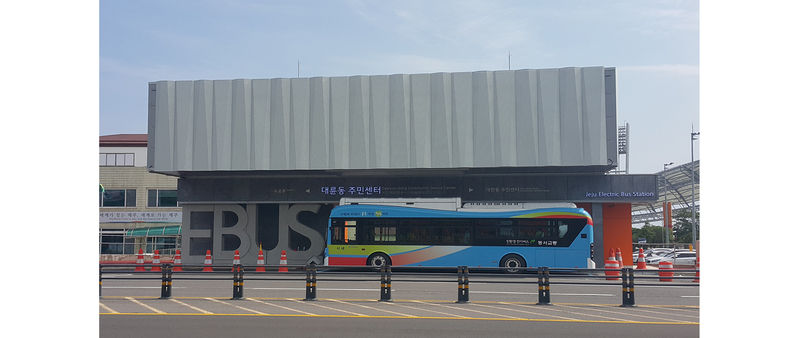
I wrote about these buses back in 2016 - Somes graphics about Chademo Charge Station.
-
The rate of battery failures for our cars is quite high - much higher than I expected from the data collected in this thread.
In comparison the Ioniq Electric battery seems to be doing well.
The Soul EV battery is made by SK Innovation. The Ioniq Electric battery by LG Chem.
Does this mean that before 2017 LG Chem had better battery tech than SK Innovation.
We don't have enough data to compare the newer cars yet.
But some data is coming in. The Kona 64kWh Electric has a battery by LG Chem.
There seems to be a common fault in the Kona 64kWh Electric where a single cell failure causes a big drop in range.
This happens to new cars with low mileage, so I assume this is a manufacturing defect not deterioration.
Will be interesting to see how this changes with time.
See this German thread for details :- Drastischer Einbruch der Reichweite um gut 30% - Akku zeigt 100% - lädt aber nur effektiv rund 70%
On the plus side for LG Chem. See this Korean article about electric buses in Jeju.
Many Electric Buses in South Korea Go over 300,000 in Kilometrage and Proving Better Economic Feasibility than Regular Buses
...The battery capacities (102 kWh and 156 kWh) of these electric buses are smaller than that of electric buses (200 kWh) that have come out on the market recently. As a result, these buses drive for 320 km on average daily while traveling back and forth from Jungmun-dong and Namwon-eup and they need to be recharged for every 70 to 80 km. This indicates that these buses have gone through 4,500 to 5,000 charges and discharges that are 1.5 times more than the number of charges and discharges that the industry guarantees which is at 3,000..

I wrote about these buses back in 2016 - Somes graphics about Chademo Charge Station.
-
2016 Kia Soul - Previously a Teo taxi
~145,000km as of posting
SOH: 74%-65% (It has fluctuated that much in the last two charges..)
I have an appointment with my local dealership next week to get it looked at, but something tells me that despite me being extremely clear about what I need done - it's still going to be a struggle. Hopefully I'm wrong, time will tell.
I'm really curious if there's any theories to why the rate of replacement is so high in these compared to the Nissan LEAF despite the active air battery cooling design vs the LEAF's passive design? I know the chemistry is different, but any chance there was just a defect in manufacturing that dooms these batteries, or what's going on? I'm really hoping that the replacement battery holds up better than the original..
~145,000km as of posting
SOH: 74%-65% (It has fluctuated that much in the last two charges..)
I have an appointment with my local dealership next week to get it looked at, but something tells me that despite me being extremely clear about what I need done - it's still going to be a struggle. Hopefully I'm wrong, time will tell.
I'm really curious if there's any theories to why the rate of replacement is so high in these compared to the Nissan LEAF despite the active air battery cooling design vs the LEAF's passive design? I know the chemistry is different, but any chance there was just a defect in manufacturing that dooms these batteries, or what's going on? I'm really hoping that the replacement battery holds up better than the original..
Similar threads
- Replies
- 9
- Views
- 1K
- Replies
- 3
- Views
- 761
- Replies
- 8
- Views
- 3K
- Replies
- 7
- Views
- 468



















